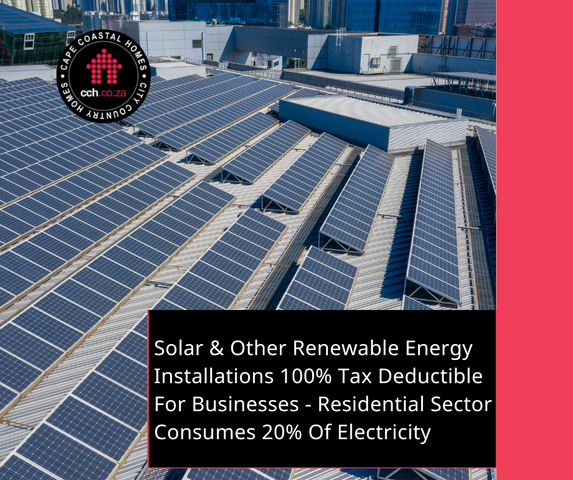Solar & Other Renewable Energy Installations 100% Tax Deductible For Businesses - Residential Sector
We are in the middle of an energy management crises called "load shedding" with a minimum time frame for a solution offered by Eskom looking to be round about October 2024 - i.e. when the amount of additional renewable energy generation capacity to be procured from bid window 6 will reach 4.2GW.
Removal of the licensing threshold for private generation and the relaxation of environmental authorisations in areas where the risk to the environment is low, are two measures now taken to facilitate the addition of more capacity to the grid. Calls for reduced demand, while the new solutions are underway, means that government and Eskom would like us to reduce our consumption as much as possible until at least October 2024. Eskom continues to apply for a tariff increase on an alarmingly regular basis
- Tax allowance for businesses installing solar panels
Fortunately, South Africa has since 2015 an accelerated capital allowance or 100% tax deduction in place for movable assets used in the production of renewable energy - a 100% deduction in the first year (of tax assessment) for any plant or machinery brought into use.
The allowance is only available if the asset is brought into use for the first time by the taxpayer and is not limited to new or unused assets. The wording merely prevents the taxpayer from claiming the section 12B allowance twice on the same asset. The tax deduction also applies to the direct cost of installation and to any subsequent improvements to it - excluding repairs. The installation planning costs, panel delivery costs and installation safety officer costs are also deductible from income tax.
It would be very interesting to determine (1) how many companies have benefitted from the scheme (2) the tax savings achieved and (3) the additional MW electricity generated during the last 6 years, due this scheme.
The new businesses and jobs created by this scheme is invaluable - a pure win-win for our country.
- What if I install solar panels at my home?
Section 12B of the Income Tax Act requires that the solar panels be used during the taxpayer's trade. If the solar panels are exclusively used for domestic and private purposes, no deduction can be claimed.
However, individuals are increasingly working from home, and it may be that the solar panels are wholly or partially utilised for a home office. In this case, the expenses may still qualify for a deduction, but subject to section 23(b) and 23(m) of the Income Tax Act, which sets out the rules for home office expenditure.
Employees working from home are subject to the limitations of both section 23(b) and 23(m) of the Income Tax Act and must be able to prove that they have a dedicated office space which is specifically equipped for that purpose and is regularly and exclusively used for such purposes. The taxpayer may then only deduct expenditure incurred for such exclusive office space, limited to rental, repairs and expenses related to the premises, which may include the installation of solar panels.
Therefore, employees must pass the general home office expenditure requirements in terms of sections 23(b) and 23(m) of the Income Tax Act, which may then allow them to deduct a proportional amount of the expenditure of the installation of the solar panels.
It is therefore important that taxpayers carefully consider whether they comply with the requirements of the Income Tax Act before deducting any expenditure and apply their minds when apportionment of expenses must be made.
- National "solar picture" in South Africa
According to US Energy Information Administration (US EIA), by 2040, it is estimated that the residential sector in South Africa is likely to consume approximately 8.4 mtoe ( million tonnes of oil equivalent) or 98,000 kWh of electricity.
According to South Africa Photovoltaic Industry Association (SAPVIA), as of 2021, South Africa had over 4 GW of solar energy connected to its grid. The residential segment accounts for less than 20% of the total capacity.
As part of South Africa's long-term energy plan, the government will add another 6 GW of solar power to the grid by 2030 - which will increase the PV installed capacity from 3% of the current total electricity supply to 11% by 2030. The IRP electricity infrastructure development plan is based on least-cost electricity supply and demand balance, considering security of supply and the environment, and will according to the SAPVIA result in a 400%-plus increase of solar PV by 2030.
The electricity use in most of the residential sectors is likely to grow in South Africa because of increasing personal incomes and as urban migration continues in the southern regions of Africa. Moreover, the housing sector is expected to witness a considerable investment, owing to a rise in population, rapid urbanization, and increased disposable incomes.
According to Mordorintelligence.com, South Africa has great potential for renewable energy resources, especially solar and wind, the most prominent technologies in the current renewable procurement windows. South Africa has an average of more than 2,500 hours (about 3 and a half months) of sunshine per year, and the average solar radiation levels range between 4.5 and 6.5 kWh/m2 per day.
The country's Northern Cape is one of the world's most attractive solar resource areas.
Author Benhard Wiese

